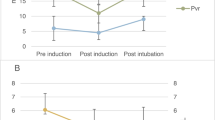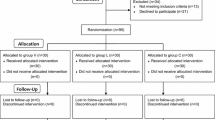Abstract
Purpose
Rocuronium and propofol are used in the induction of anesthesia give discomfort to the patients. We aimed to investigate the relationship between venous diameter measured using ultrasonography, and pain and withdrawal movements after propofol and rocuronium applied with intravenous (IV).
Methods
This prospective-observational study was performed on 142 voluntary patients undergoing surgical operation under general anesthesia. An ultrasonography was used to measure the vein transverse diameter. Patients with a venous transverse diameter of ≤2 mm were classified as group 1 (n = 50), while patients with a diameter of > 2 mm were classified as group 2 (n = 92). The propofol pain was assessed according to the verbal rating scale (VRS). In addition, the withdrawal movements of the rocuronium injection were evaluated using the four-point scale.
Results
There was no difference between the two groups in terms of the demographic data. The patients have pain after propofol 38.2% and withdrawal movements after rocuronium 42.4% were detected. The maximum number of patients without pain after propofol injection (78.2%) and without withdrawal movements after rocuronium (76%) was found to be higher in group 2 (p = 0.001).
Conclusion
In this study, we found a reduction in the incidence and severity of pain and withdrawal movements in intravenous propofol and rocuronium administration through peripheral venous vessels of large diameter. We believe that the clinical drug injection through vessels with large venous diameter with the help of USG may be a non-invasive, simple, and reliable method to reduce pain and withdrawal movements in propofol and rocuronium injections.

Similar content being viewed by others
References
Hudson RJ, Henthorn TK. Basic principles of pharmacology in anesthesia practice. In: Cullen BF, Stoelting RK, Barash PG, editors. Clinical Anesthesia. 5th ed. Philadelphia: Lippincot Williams & Wilkins; 2006. p. 246–471.
Yılmaz S, Uğur B, Oğurlu M. Evaluation of pain and hemodynamic variables associated with rocuronium injection. Türkiye Klinikleri J Anesthesiol Reanim. 2012;10:21–7.
McCrirrick A, Hunter S. Pain on injection of propofol: the effect of injectate temperature. Anaesthesia. 1990;45:443–4.
Borgeat A, Kwiatkowski D. Spontaneous movements associated with rocuronium: is pain on injection the cause? Br J Anaesth. 1997;79:382–3.
Şimşek Ülkü H, Güneş Y, Ilgınel M, Biricik E, Karacaer F. Effect of rocuronium administration rate and remifentanil on prevention of rocuronium injection pain in pediatric cases. Agri. 2017;29:162–6. https://doi.org/10.5505/agri.2017.83584.
Steegers MA, Robertson EN. Pain on injection of rocuronium bromide. Anesth Analg. 1996;83:193–205.
Joshi GP, Whitten CW. Pain on injection of rocuronium bromide. Anesth Analg. 1997;84:228–36.
Cheong KF, Wong WH. Pain on injection of rocuronium: influence of two doses of lidocaine pretreatment. Br J Anaesth. 2000;84:106–7.
Nathanson MH, Gajraj NM, Russell JA. Prevention of pain on injection of propofol: a comparison of lidocaine with alfentanil. Anesth Analg. 1996;82:469–71.
Tan CH, Onsiong MK. Pain on injection of propofol. Anaesthesia. 1998;53:468–76.
Scott RP. Saunders DA., Norman J: propofol: clinical strategies for preventing the pain of injection. Anaesthesia. 1988;43:492–4.
Tariq MA, Kamran M. Incidence of pain on propofol injection and efficacy of addition of lignocaine or selecting big vein or both combined in reducing it: a randomized control trial. J Postgrad Med Inst. 2006;20:8–11.
Lui JT, Huang SJ, Yang CY, Hsu JC, Lui PW. Rocuronium-induced generalized spontaneous movements cause pulmonary aspiration. Chang Gung Med J. 2002;25:617–20.
Klement W, Arndt JO. Pain on i.v. injection of some anaesthetic agents is evoked by the un physiological osmolality or pH of their formulations. Br J Anaesth. 1991;66(2):189–95.
Tuncali B, Karci A, Tuncali BE, Mavioglu O, Olguner CG, Ayhan S, Elar Z. Dilution of rocuronium to 0.5 mg/mL with 0.9% NaCl eliminates the pain during intravenous injection in awake patients. Anesth Analg. 2004;99:740–3.
Borgeat A, Kwiatkowski D, Ruetsch YA. Spontaneous movements associated with rocuronium injection: the effects of prior administration of fentanyl. J Clin Anesth. 1997;9:650–2.
Lockey D, Coleman P. Pain during injection of rocuronium bromide. Anaesthesia. 1995;50:474.
Blunk JA, Seifert F, Schmelz M, Reeh PW, Koppert W. Injection pain of rocuronium and vecuronium is evoked by direct activation of nociceptive nerve endings. Eur J Anaesthesiol. 2003;20:245–53.
Baek SH, Woo CM, Lee HJ, Yoon JY, Kwon JY, Shin SW. Rocuronium-induced withdrawal movements associated with different rocuronium injection method. Paediatr Anaesth. 2008;18:515–9.
Chiarella AB, Jolly DT, Huston CM, Clanachan AS. Comparison of four strategies to reduce the pain as sociated with intravenous administration of rocuronium. Br J Anaesth. 2003;90:377–9.
Zhang XM, Wang Q, Wang WS, Wang M. Large vein injection alleviates rocuronium-induced pain in gynaecologic patients. Anaesth Crit Care Pain Med. 2017;36:233–5. https://doi.org/10.1016/j.accpm.2016.03.010.
Clinical pharmacology. In: John F. Butterworth IV, David C. Mackey, John D. Wasnick, editors. Morgan & Mikhail’s Clinical Anesthesiology 5th ed. Los Angeles: Appleton&Lange; 2013. p.143-277.
Lee YC, Jang YH, Kim JM, Lee SG. Rapid injection of rocuronium reduces withdrawal movement on injection. J Clin Anesth. 2009;21:427–30.
Shin YH, Kim CS, Lee JH, Sim WS, Ko JS, Cho HS, Jeong HY, Lee HW, Kim SH. Dilution and slow injection reduces the incidence of rocuronium-induced withdrawal movements in children. Korean J Anesthesiol. 2011;61:465–9.
Akkaya T, Toygar P, Bedirli N, Yazıcıoğlu D, Gümüş H. Effects of pretreatment with lidoca -ine or ketamine on ınjection pain and with drawal movements of rocuronium. Turk J Med Sci. 2008;38:577–82.
Author information
Authors and Affiliations
Corresponding author
About this article
Cite this article
Yılmaz, S., Hatiboğlu, Y. The evaluation of the effect of venous diameter measurement by ultrasonography on pain and withdrawal response. J Anesth 32, 375–380 (2018). https://doi.org/10.1007/s00540-018-2489-5
Received:
Accepted:
Published:
Issue Date:
DOI: https://doi.org/10.1007/s00540-018-2489-5




